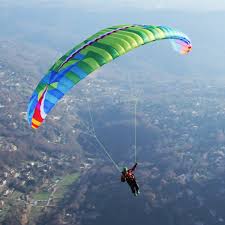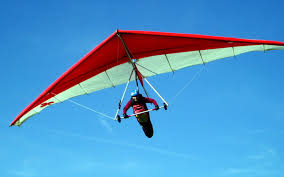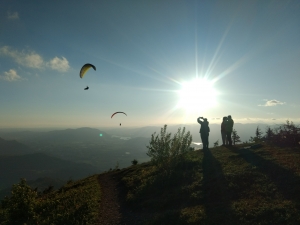What is paragliding?
Paragliding is the simplest form of human flight. There is no motor, no cockpit, no glass, nothing between you and the wide open air. The paraglider itself is a fabric wing with similar aerodynamic properties as an airplane wing, and you are suspended underneath in a comfortable hammock-type harness. With a paraglider you get to experience the world from above, something not many people get to experience, and it’s the closest thing to actually flying like a bird.
Is paragliding like parasailing, skydiving, BASE jumping?
These other activities are often confused with paragliding. Parasailing is being pulled up behind a boat where you have no control yourelf, and everything is controlled by the boat operator. This is a common attraction at oceanside resorts. Skydiving is where you jump out of an airplane and drift to the ground; you can’t stay aloft with a skydiving parachute whereas you can stay up for hours with a paraglider! Base jumping is an advanced form of skydiving, where a similar parachute is used to also drift you to the ground, just starting from a fixed object (like a bridge) rather than an airplane. The main difference between all of these and paragliding is that, with skill, you can stay up and fly around for hours, much like an airplane, just without the noise and smell!
How is paragliding different from hang gliding?

Paraglider

Hang Glider
The main difference is the equipment and how you are positioned underneath, the weight, and the takeoff and landing speeds. With a paraglider you are seated in a comfortable harness, facing feet-first as if you were in an reclining chair. The canopy is wing-shaped (with the same concept as an airplane wing) and made of pliable fabric. You, in your harness, are suspended under the canopy via a network of incredibly strong lines. The entire package can fit in a backpack ranging from small daypack size (5 kg) to hockey bag size (20 kg), depending on your body size and accessories. Taking off and landing are generally slower, ranging from a slow walk to a light jog. With a hang glider you are fitted in a harness, facing head first like Superman, and suspended under a rigid delta-shaped wing. Taking off and landing are generally faster than on a paraglider, and most hang gliders weigh between 25-35 kg.
Are there any physical limitations?
Not really! Most of your time is spent sitting in your harness, looking out over the landscape, and there is little physical activity outside the actual taking off and landing part, which involve jogging/running a few steps. Due to the size of the equipment, there is a general maximum weight of 300 lbs (135 kg) but even then there are options. If you have bad or arthritic knees you may have some issues with the takeoff and landing; please check with us if you are unsure. Even if you are hard-of-hearing, visually impaired, or even in a wheelchair it’s possible to paraglide!
How much do lessons cost?
At XCParagliding we specialize in certifying pilots to the “Novice” stage, which is the minimum required by the national organization in order to fly on your own. This course costs $XXXX and consists of extensive ground school, simulator training, bunny hill laps, 25 flights, and the written test.
How long does it take to learn?
Paragliding is easy to learn but in order to progress and become proficient takes some time commitment. In Canada, we require a minimum of 25 flights and passing a written test before you can be “signed off” (allowed to fly unsupervised), although we may choose to bump that to 30 or 35 flights if we feel more training is necessary. Due to fact that paragliding is weather-dependent, lessons can take anywhere from 2 weeks to several months to complete, depending on what time of year you are doing your lessons.
How do I get started?
Generally, most people start off paragliding by taking a tandem flight, where you are strapped in with a licensed instructor under the same tandem paraglider (this is an extra-large paraglider built for two). The licensed instructor is in control at all times and you, as the passenger, are welcome to take in the views and relax, or you can request a bit more excitement! If you enjoy the experience and want to try solo paragliding, we can get you started with ground school, simulator training followed by a trip the “bunny hill” to get your first flight hops in. Then we take you up the mountains for your first solo flights! At all times you are in radio contact with the instructor who will tell you exactly what to do. Please see our Tandem page for more information.
How much does a paraglider cost?
Paragliding is much like skiing…you make an initial outlay of money to buy everything, but once you have it you are free to go where you like! A brand-new paraglider will range anywhere from $4000-$5000 but you can get second-hand paragliders for half that (or less). They are designed to last for many hundreds of hours, so unless you are a heavy-user you will get many years out of it. Paragliders, so long as they are not too old, are much sought-after so selling your paraglider is generally quite easy if you want to upgrade!
Do I need a license to fly?
Paragliding in Canada is self-regulated, which means that Transport Canada leaves it to the national organization (Hang Gliding and Paragliding Association of Canada) to regulate its members. We recommend all pilots, once you have completed your lessons), become a member of HPAC in order to take advantage of their liability insurance program. Many takeoffs and landings are on property either controlled by a local Club, or by a private landowner, and both will require proof of liability insurance which HPAC membership provides.
What can I do with a paraglider?

Paragliders at Elk Mountain near Chilliwack.
Paragliders are great in that they can take you places most people never get to see! It’s just like being in an airplane, except quiet, and you are of course not as high as an airplane, which means you can get some fantastic close-up views of mountains, clouds, and wildlife. Most paraglider pilots, at some point, want to start straying from their home site and fly to somewhere else. We call that “going cross country”, and you can travel a long way! The current World record is over 500km and the Canadian record is over 300km! You can also use a paraglider to visit places which are not easily accessible by foot (or not at all), simply by flying there and skipping the days-long hike to that same spot. Other pilots looking for a different sensation will often use their paraglider for acrobatics or attach a motor and turn it into a paramotor so they can fly even when it’s not windy or thermic enough for regular paragliding.
How safe is paragliding?
Due to the fact that paragliding involves being high up in the air, there is always an element of danger. Back in the days when paragliding was in its infancy there were many more accidents than today. Technology has improved dramatically since those early days so the equipment is much more robust and has many built-in safeguards. As well we now have a deeper pool of knowledge so instructors (all of whom have been vetted by our national organization as professionally trained and certified) are able to share information and ideas. Many people ask “how dangerous is paragliding”? A comparable activity, when it comes to danger, would be motorcycle riding. Compared to other aerial sports, paragliding is much safer than basejumping and wingsuiting, due in large part to the fact that those sports involve being very close to terrain while at high speeds. Most accidents in paraglider involve twisted ankles (if you have a hard landing or land in a gopher hole) and sunburn. Less common are back injuries although this can be mitigated through proper harness padding and safety training.

